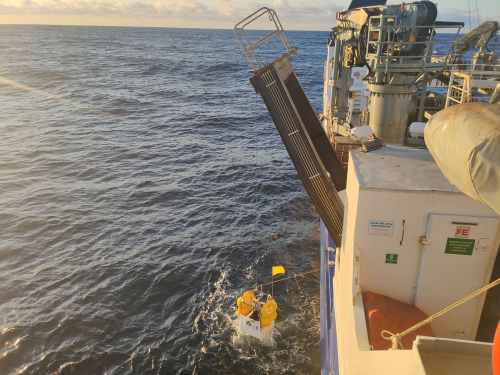
R/V Tangaroa returns to the Hikurangi subduction zone in search of slow slip

A team of scientists from GNS Science, Victoria University of Wellington, the University of Tokyo, and Tohoku University are at sea off the coast of Gisborne onboard NIWA research vessel Tangaroa, deploying sensors to detect slow slip earthquakes on the Hikurangi Subduction Zone.
The Hikurangi Subduction Zone is where the Pacific Plate subducts, or dives under, the Australian Plate offshore the North Island’s east coast. This is New Zealand’s largest and most active fault. A major earthquake on the subduction zone could cause a tsunami similar to that seen in Japan in 2011.
Slow slip earthquakes occur when energy that has built up along the subduction zone releases slowly, rather than in a big jolt as in an earthquake.
Understanding how slow slip earthquakes occur can help scientists to better understand how and why large earthquakes happen.
This is the second voyage to deploy these instruments as part of a Marsden-funded project, with support from MBIE Endeavour. In September, the team retrieved instruments that were deployed for a year offshore the Pōrangahau area, and they are headed back out this week to redeploy the instruments offshore Gisborne for another year of measurements on the seafloor.
The sensors offshore of Pōrangahau successfully recorded a slow slip event that occurred beneath the seafloor instrument network in late May of this year.
“Preliminary analysis of the data has already found exciting results” says Dr Laura Wallace “our sensors detected frequent recordings of tremor on the offshore subduction zone, including during the Pōrangahau slow slip event in late May of this year. We are only able to detect this offshore tremor with the ocean bottom sensors, so this is the first time we have been able to track out the tremor during slow earthquakes in this area.”
Tremor is a type of earthquake, detected on seismometers as a rumbling that occurs without the distinctive jolt of energy that is released in a typical earthquake.
Slow slip earthquakes, such as those offshore the Pōrangahau and Gisborne areas are also associated with earthquake swarms.
Swarms are clusters of multiple earthquakes of a similar size, close by to one another. Recording these gives insight into how slow slip events impact the likelihood of future earthquakes and could one day help scientists to do a better job forecasting earthquakes.
“Large slow slip earthquakes happen frequently off of the coast of Gisborne, so redeploying our instruments there this year gives us lots of opportunities to catch the next slow earthquake and learn more about these events.”
The team returns to Wellington on October 20th.
10 February 2023
Disclaimers and Copyright
While every endeavour has been taken by the East Coast Lab Hikurangi Subduction Zone M9 to ensure that the information on this website is
accurate and up to date, East Coast Lab Hikurangi Subduction Zone M9 shall not be liable for any loss suffered through the use, directly or indirectly, of information on this website. Information contained has been assembled in good faith.
Some of the information available in this site is from the New Zealand Public domain and supplied by relevant
government agencies. East Coast Lab Hikurangi Subduction Zone M9 cannot accept any liability for its accuracy or content.
Portions of the information and material on this site, including data, pages, documents, online
graphics and images are protected by copyright, unless specifically notified to the contrary. Externally sourced
information or material is copyright to the respective provider.
© East Coast Lab Hikurangi Subduction Zone M9 - www.eastcoastlab.org.nz / +64 6 835 9200 / info@eastcoastlab.org.nz
